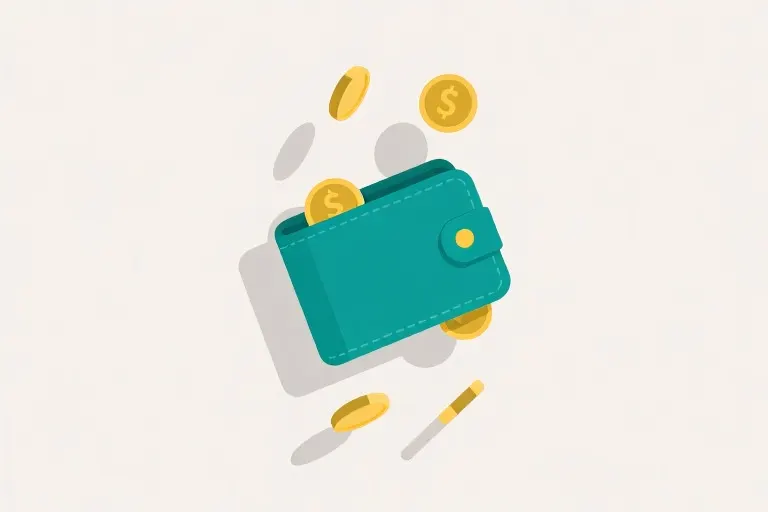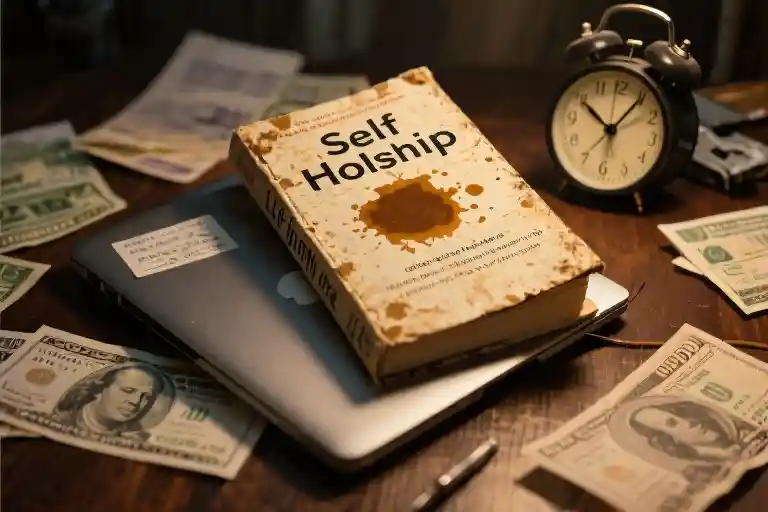That $10 coffee you grab every morning seems insignificant, doesn’t it? Just a small treat to start your day. But let’s do some quick math together – $10 daily becomes $300 monthly, $3,650 annually. Now project that over ten years with modest 5% investment returns, and you’re looking at nearly $50,000. That’s a used luxury car, a down payment on a house, or two years’ tuition at community college.
We’re not here to judge how you find joy. Your money, your choices. But if you’re part of the 60% Americans living paycheck to paycheck (or worse, drowning in credit card debt), those ‘harmless’ little expenses become financial termites – quietly eating away at your future.
This isn’t about deprivation. It’s about awareness. The average millennial spends $2,008 annually on coffee, $1,092 on food delivery, and – here’s the kicker – $600 on subscription content like OnlyFans according to 2023 consumer reports. Combined, that’s enough to:
- Fully fund an IRA contribution
- Pay off most people’s credit card interest
- Cover 3 months of emergency expenses
What makes these money wasting traps particularly dangerous isn’t the dollar amounts, but the psychological factors:
- The ‘It’s Just $10’ Effect: Our brains categorize small purchases differently than large ones
- Subscription Creep: Automated payments make spending invisible
- Emotional Band-Aids: Using purchases as quick mood boosters
Over the next sections, we’ll unpack 11 of these financial illusions – from OnlyFans addictions to DoorDash dependence. For each, you’ll get:
- Reality check: What you’re actually spending
- Wake-up call: What that money could become
- Painless alternatives: Equal pleasure, zero guilt
Remember: This isn’t about cutting joy from your life. It’s about removing the expenses that bring no real happiness so you can fund what truly matters. Because financial freedom isn’t built in dramatic gestures, but in hundreds of small, smart decisions.
“Watch the pennies and the dollars will take care of themselves.” – Benjamin Franklin (though he’d probably cry seeing $7 avocado toast)
The Sneaky Subscription Drain: OnlyFans and Beyond
Let’s talk about those small, recurring charges that barely register on your radar. The $10 here, $20 there – they feel insignificant in the moment, but collectively? They’re quietly siphoning off chunks of your potential savings. This financial ‘death by a thousand cuts’ phenomenon hits hardest with subscription services, particularly in the adult content space.
The Slow Bleed of Content Subscriptions
Platforms like OnlyFans have mastered the art of painless payments. With average users spending around $50 monthly (according to 2023 industry reports), that’s $600 annually – enough for a decent vacation fund or three months of grocery bills. What makes these charges particularly insidious:
- The convenience factor: One-click payments remove spending friction
- The privacy element: These charges often appear as discreet line items
- The dopamine effect: Each payment feels like a personal indulgence
Here’s the uncomfortable truth: 78% of creators earn less than $1,000/month on these platforms (OnlyFans internal data, 2022). That means most subscribers are funding a system where only the top 2-3% see substantial earnings.
Smarter Alternatives That Won’t Empty Your Wallet
If you’re looking for free alternatives to OnlyFans, consider these options that deliver similar content without the financial drain:
- Platforms with free tiers: Many mainstream sites offer robust free content libraries
- Creator Twitter/X accounts: Numerous artists share substantial free preview content
- Niche forums and communities: Often host user-shared media at no cost
For those considering content creation as a side hustle, the numbers tell a sobering story. The average OnlyFans creator spends 20+ hours weekly to earn approximately $180/month (2023 Creator Survey). That’s below minimum wage in most states after platform fees.
Turning Consumption Into Creation
Instead of spending on content, why not flip the equation? Here’s why writing ebooks outperforms adult content platforms for most aspiring creators:
| Metric | OnlyFans Average | Ebook Publishing |
|---|---|---|
| Hourly Earnings | $8-12 | $25-50+ |
| Passive Potential | Low | High |
| Platform Fees | 20% | 30-70% |
| Content Lifespan | Days/Weeks | Years |
Pro Tip: Platforms like Amazon KDP require no upfront costs and offer 35-70% royalties. A single $2.99 ebook sale nets you about $2 – the same as an OnlyFans subscription, but without monthly content demands.
The Financial Wake-Up Call
That $50/month content habit could instead become:
- $600/year in a Roth IRA
- 6 months of Spotify Premium
- A decent starter investment portfolio
Before your next subscription payment, ask yourself: “Is this temporary entertainment worth more than my long-term financial freedom?” Sometimes the most powerful financial move isn’t earning more – it’s stopping the leaks you’ve learned to ignore.
Financial Health Tiered Guide
Now that we’ve exposed those sneaky spending habits draining your wallet, let’s talk solutions tailored to your specific financial situation. Whether you’re comfortably covering bills or drowning in debt, these actionable strategies will help you regain control.
For Those Who Can Afford It: The 3-Step Entertainment Budget Firewall
- Define Your Fun Money
- Calculate 5-10% of your after-tax income as your monthly “guilt-free spending” allowance. This isn’t about deprivation – it’s about conscious enjoyment. Track this using apps like Mint or YNAB (You Need A Budget).
- Create Spending Buckets
- Divide your entertainment budget into categories:
- Digital subscriptions (OnlyFans, Netflix, etc.)
- Food delivery services
- Impulse purchases
- When one bucket empties, resist borrowing from others. This teaches prioritization.
- Implement The 72-Hour Rule
- For any non-essential purchase over $20, wait 3 days. Most “must-have” urges disappear, saving you from money wasting traps. As behavioral economist Dan Ariely notes, “Time is the enemy of irrational decisions.”
Remember: The goal isn’t to eliminate joy, but to prevent small leaks from sinking your financial ship. As long as you stay within these self-imposed limits, that occasional DoorDash order or premium content subscription won’t derail your future.
For Those in Debt: The 7-Day Spending Detox Challenge
When you’re carrying debt, every dollar counts. This intensive reset helps break compulsive spending cycles:
Day 1-3: The Cleanse
- Freeze all non-essential spending (groceries/utilities only)
- Unsubscribe from marketing emails and delete food delivery apps
- Carry only cash for necessary purchases
Day 4-5: Awareness Training
- Review bank statements to identify emotional spending triggers
- Create a “Why I Want Out of Debt” vision board
- Practice free stress relievers (walking, meditation, library books)
Day 6-7: Strategic Planning
- List all debts by interest rate (attack the highest first)
- Cook one week’s meals using pantry staples
- Set up automatic transfers to savings (even $5/week builds momentum)
Pro Tip: Enlist an accountability partner. Research shows public commitments increase success rates by 65%. Text a friend: “I’m doing a 7-day spending detox – ask me daily if I’ve stuck to it.”
The Psychology Behind Lasting Change
Both approaches work because they:
- Replace deprivation with structured freedom (firewall method)
- Create dramatic early wins to build confidence (detox challenge)
- Address the emotional roots of spending rather than just the behavior
As money expert Ramit Sethi observes, “Personal finance is 80% psychology and 20% math.” Whether you’re setting gentle boundaries or doing financial triage, the key is consistency over perfection.
Your Next Step: Choose one strategy based on your current financial health. For extra credit, calculate how much you’d save annually by implementing these changes – that future version of yourself will thank you.
Take Action Now: Small Steps to Big Savings
You’ve just uncovered 11 sneaky spending habits that might be draining your wallet without you realizing it. Awareness is the first step, but real change happens when you take action. Here’s how to turn these insights into lasting financial improvements.
Your Free Spending Tracker Template
Knowledge without tracking is like driving without a dashboard – you’ll never see the problem until it’s too late. That’s why we’ve created a simple free spending tracker template (no email required) to help you:
- Visually map where your “small” purchases go
- Spot patterns in your emotional spending triggers
- Calculate what those daily lattes really cost annually
Pro tip: For the next 7 days, record every purchase – even that $1.99 app store charge. You’ll likely discover at least 3 subscriptions you forgot about (the average person has 12 recurring payments they don’t use).
Join the #WasteFreeChallenge
Changing habits works better with community support. Starting this Monday, we’re kicking off a 30-day #WasteFreeChallenge where you’ll:
- Pick one useless spending habit to eliminate (ex: food delivery apps)
- Share your daily wins in our Facebook group
- Get access to live Q&A with financial coaches
The most creative money-saving hack each week wins a $50 grocery gift card (ironic, we know). Last month’s winner replaced her $15 daily salad bar habit with DIY mason jar salads – saving $300 while eating healthier.
What’s Next? The 5 “Fake Frugal” Traps
Think you’re being smart with money? Our next expose reveals how “budget” behaviors like:
- Bulk buying that leads to waste
- Subscription bundles that cost more
- DIY projects that backfire
…actually cost you 23% more than regular spending (University of Michigan study). Click the bell icon to get notified when we publish it.
Your Turn: Share Your Money Win
What’s one useless spending habit you’ve successfully kicked? How much did you save? Drop your story in the comments – your experience might be the nudge someone needs to start their own financial turnaround.
Remember: Financial freedom isn’t about deprivation. It’s about consciously choosing what deserves your hard-earned dollars – so you can afford what truly matters without guilt or stress.





